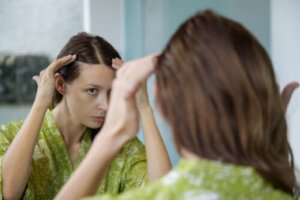Hairskincare: The Trend to Keep Your Hair Healthy


Reviewed and approved by the nurse Leidy Mora Molina
Skin care includes the whole body, face, and scalp. Sometimes, however, we neglect the attention that the hairy dermis needs, trusting that a shampoo and conditioner will do all the work. But it takes more than the application of cleansers to take care of our skin, and this is what hairskincare is all about .
The trend is all about skin care. Exfoliating, moisturizing, and other treatments promote hair health. The positive effects come from the care with which you pamper the scalp because and provide it with vitamins and nutrients.
What is “hairskincare” and what are its benefits?
Hairskincare consists of the execution of healthy routines for the hair fiber and scalp; it means that certain practices achieve a radiant, hydrated, and moving head of hair.
The process begins by pampering the skin that covers the head, sometimes weakened by inadequate cosmetics, heat, pollution, and a diet lacking in minerals and vitamins. The consequences are fragile strands, dryness, and a loss of density.
Just as you rescue the skin of the skin or the body, it’s essential to intervene in the restoration of your scalp and hair.
Actualidad Sanitaria magazine points out that the well-being of the scalp has a direct impact on the health of the hair as a whole. The publication adds that many hair problems can be solved by modifying your routines.
This is precisely what “hairskincare” proposes, with substances and methods that offer various benefits:
- They clean the hair follicle.
- They prevent hair loss.
- They regulate excess grease.
- They strengthen and illuminate the hair.
- They prevent the accumulation of dead cells.
- They help the scalp to function properly.

How to apply “hairskincare”?
The practices related to hairskincare are simple. Most of them can be done at home.
We think you may be interested in reading this, too: Get Silky Shiny Hair with this Banana and Avocado Hair Mask
Analyze your hair type
The main tip for good results is to know your hair and scalp type. By knowing whether the skin is dry, oily, or combination, you provide your body with cosmetics with the relevant ingredients.
Incorrect product selection could lead to reactions such as dermatitis or flaking. In addition, curly, straight, or wavy hair looks better when you use formulas designed for each characteristic.
Use purifying masks
Before shampooing, it is advisable to use a purifying mask. These serums help with hygiene and prepare the hair to receive vitamins and nutrients.
Make sure you wash your hair properly
A washing technique carried out in the right way contributes to blood circulation and allows hair nourishment. Rub the scalp with your fingertips; scratching with your fingernails cracks the follicles, increasing the risk of breakage.
Let the shampoo act for at least 2 minutes and rinse. Use lukewarm water when the cleanser is part of a specialized treatment.
Like this article? You may also like to read: Check Out These 12 Types of Hair Spray and How to Use Them
Know how to comb your hair the right way
Open-tooth combs are ideal for detangling without pulling hair out. When combing, never comb from the roots; instead, go from mid-lengths to ends first and then move on to the base.
A common mistake is to comb wet hair because the humidity sensitizes the fibers.
Avoid extreme heat
The best way to dry hair is to leave it in the natural air. Frequent use of blow dryers and flat irons damages the hair. When exposing your hair to heat appliances, it’s best to regulate the temperature and spray a heat protectant beforehand.
Regulate your haircut
In addition to refreshing your look, a haircut every 3 months is advisable for healthy hair growth. Trimming is a preventive measure against possible hair loss; it eliminates split ends and facilitates combing.
Try deep treatments
Peeling is no longer an exclusive treatment for the face; it’s now part of hairskincare. The aim is to detoxify and restore the scalp with substances that have the ability to completely eliminate impurities, revitalize the skin of the hair and promote the absorption of antioxidants.
After peeling, the roots become lighter and the strands become silkier.
Other techniques, such as platelet-rich plasma ampoules or hair mesotherapy, promote hair growth and help follicular differentiation, which is essential for some types of alopecia not to affect healthy follicles. In general, these methods exfoliate, suction impurities, inoculate reconstituting serums, and massage the scalp.
It’s essential that any deep treatment is carried out by professionals due to the delicacy of the substances and the knowledge of the equipment to develop it.

Precautions during your “hairskincare” routine
If throughout the routines you observe changes in your scalp, go to a stylist. When symptoms persist, the right thing to do is to consult a dermatologist.
Adverse reactions to certain products manifest themselves through symptoms such as the following:
- Oily hair
- Itching
- Dandruff
- Dryness
- Skin pigmentation shanges
- Redness
Most of the care involved in hairskincare is done at home. As long as you use the appropriate products, this kind of care should not produce hair alterations.
All cited sources were thoroughly reviewed by our team to ensure their quality, reliability, currency, and validity. The bibliography of this article was considered reliable and of academic or scientific accuracy.
- Caspa, costra láctea y otras afecciones del cuero cabelludo. Medline Plus. Biblioteca Nacional de Medicina. Institutos Nacionales de la Salud. Estados Unidos. https://medlineplus.gov/spanish/dandruffcradlecapandotherscalpconditions.html
- Consejos sencillos para cuidar tu cuero cabelludo. Actualidad Sanitaria. 2021. https://actualidadsanitaria.com/vida-saludable/consejos-sencillos-para-cuidar-tu-cuero-cabelludo/
This text is provided for informational purposes only and does not replace consultation with a professional. If in doubt, consult your specialist.








